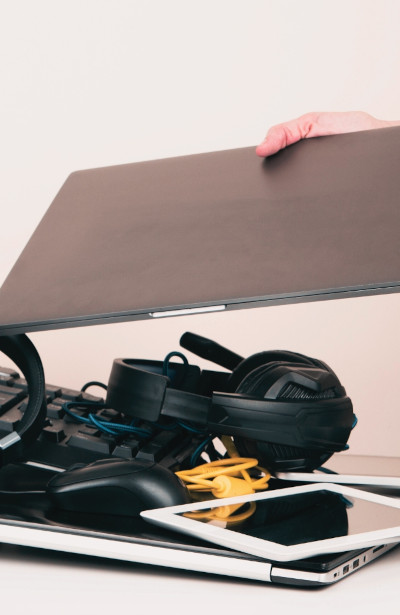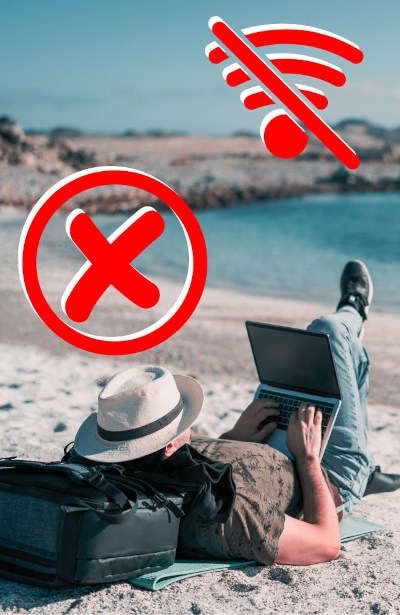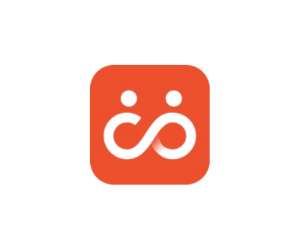You are not alone in your struggle to maintain high productivity levels while working remotely or traveling as a digital nomad. Earning the freedom to work from anywhere isn’t the end of the road. It comes with new challenges that stand between you and your focus on getting things done.
Here, I share with you seven of the most essential productivity tips that helped me stay productive and sustain a location-independent lifestyle through my eight years journey of working remotely.
1. Separate the Remote Workplace from the Home Space
The workplace, wherever it may be, is where you focus on getting things done and beating deadlines. The home space is where you relax, focus on your hobbies, and do activities without feeling the urge to finish something before a deadline. This separation is necessary to help with the mental switch between work mode & relaxing mode. For regular 9-5 jobs, the daily commute from home to work is more than enough to switch your focus from relaxing mode to work mode. In the world of remote work, you need to ensure that this mental switch happens daily by having a separate remote workplace which can be a coffee shop, a coworking space, or a dedicated work area at home.
For many people, working from home can be inevitable. If you have to do work at home for whatever reason, either temporarily or daily, make sure to have a separate area to use as your home workplace. This could be a different room or an area that you don’t use during your daily home activities. If you have limited space to set up your work-from-home area, using a room divider could be a good idea to separate your workplace from your home space.

2. Set your Time Boundaries
Having the freedom to set your own schedule is a blessing and a curse at the same time. If you don’t set clear boundaries in your daily schedule, you will soon suffer from stress and burnouts. No wonder many office employees worldwide were craving to go back to their offices after the rigorous Covid restrictions were lifted. This makes much sense because working at home daily removed the time and location boundaries between work and non-work activities.
It is an easier thing to do if you have a remote full-time job since the working hours will set the work time boundaries. You will only need to make it clear when you are available to work and when you are not. This is not the case for entrepreneurs and freelancers, especially for those who are at the beginning of their journey. With no time boundaries in place, work will seem endless, putting more stress on you and turning the location-independent life into a nightmare. Setting daily start and end times for your work, even splitting your work hours into 2 sessions, is as important as the separation between the workplace and the home space.
You also need time to think and reflect, especially if you do creative work. Make sure to leave unscheduled hours for that purpose. This is what Amy Whitaker, the author of Art Thinking: How to Carve Out Creative Space in a World of Schedules, Budgets, and Bosses, refers to as “Studio Time”. Here is a quote from an interview with Financial Times:
“Finding those unscheduled hours to explore something new is a challenge, so ask yourself how much time or space can you afford. Is it possible to skip a meeting every other week? Can you reduce the number of hours you watch television each night? Think of your studio time as a period to indulge your curiosity. Do anything you want with that time . . . The point is to give yourself ritualized time and space to learn and do.”
Amy Whitaker, Financial Times – MBA-toting evangelist for ‘art thinking’ at work
3. Develop your Flexi-Routine and Stick to it
Remote work introduces more flexibility to your daily routines and opens the door for you to have different life experiences, but it can turn your life into a boring and unorganized mess. Humans are creatures of habit. We create our own routines even without intending to do so. You can think of the flexi-routine as your usual daily routine with more freedom to change locations and have more time flexibility.
Here is an example to depict the difference between a 9-5 life routine and a location-independent life flexi-routine. While working 9-5, your morning routine will include waking up at a specific time, having your morning breakfast & morning coffee at the same place, doing daily morning chores, using the same means of transportation, taking the same road to work, working from the same office and the same desk every single day. A Flexi-routine will include the same actions with flexibility in the ways of performing them, such as exploring a new cafe for your morning coffee, working from a different area in your city, or even changing your work time to the time of the day when you feel most productive.
4. Reduce the Surrounding Distractions
Traditional office spaces are supposed to be set up to help you focus on work. However, they are full of annoying distractions like office noise, workplace drama, or unwanted chitchats with your colleagues. On the other hand, the remote work environment is where you choose it to be. Thus, you can have more control in eliminating distractions. Those distractions can be categorized into 2 types, audible and visual distractions.
It is clear that loud noise won’t help you focus and that you should avoid places with loud noise, but how about a bit of background sound? The background sound of a coffee shop or low-volume music can actually boost your productivity. There is even a term for it that was coined by neuropsychology researcher Onno van der Groen. It is called “The Coffee Shop Effect”. During work from home days, this effect can be replaced by a white noise soundtrack.
When it comes to visual distractions, working in a place where so much is happening will draw their focus away from work. Not only a busy place with people around you having fun but also a home desk facing your bed or your sofa where you sit while watching TV will draw your attention from what you are working on.
Personally, I prefer working with a view of the outside, like facing a window or a spacious work-friendly cafe. As a result, I choose to have my home desk facing a window, work from open-air coffee shops, or spacious coworking spaces with big windows. Your preference could be different, so make sure to choose a work location with a less distracting view.
5. Make your Desktop as Portable as Possible
As discussed, if you prefer to work from home, you would need to change views from time to time. The presence of other humans doing their own things and the background will have a positive effect on recharging your productive energy. In order to be ready, you need to look into how portable your desktop is.
To increase the portability of your desk, start by listing all the must-have items on your desk and pick a backpack that can comfortably fit all of them. For example, your portable desktop can consist of a laptop, a laptop stand, a portable keyboard, a wireless mouse, and headphones.
If using a second monitor is necessary, and you don’t wanna be tied to working from the same desk every day, there are many reliable portable 14-15 inch screens on the market. Here are some good options starting at ~$150: Asus ZenScreen, Lenovo ThinkVision M14, and VIewSonic VA.

6. Don’t Travel Very Often
Location independence comes with the temptation of traveling, seeing new places, and having new experiences. Also, traveling requires researching flights, finding places to stay, exploring suitable places to work from, meeting new people, making new connections, and adapting to a new place’s culture, weather, food, and more. If you move around very often, travel planning can draw your focus away from work.
The point of being location-independent is to have the freedom to work from wherever you want and to broaden your options in life. This shouldn’t result in living an exhausting lifestyle by always being on the move as if you are running away from something. If you want more inspiration to have a sustainable and productive digital nomad lifestyle, check out this article discussing different digital nomad travel and work styles.
7. And, of course, Don’t Work at the Beach 😉
I have mentioned this in previous articles and in one of my tweets, and here I say it again, the beach isn’t a good environment for focusing and getting things done. The wind, the sand, the sun glare on your screen, people having fun around you, and many other distractions that make it one of the most unproductive environments on the planet.
Don’t be fooled by the pictures you find everywhere on the internet of people lying down on hammocks or even dipping their toes in swimming pools while working on their laptops. Those pictures are just to lure you into reading whatever content that will end by offering 90% off a course. They are unrealistic and are only placed to grab your attention, nothing more.

It Doesn’t End Here!
Working remotely is a goal worth achieving, but it isn’t the end of the road. It takes some work and discipline to stay productive and enjoy a sustainable location-independent lifestyle. The tips in this article should help you achieve this goal. If you have any more useful tips that you would like to share, you are welcome to share your thoughts in the comments section below.







Leave a Reply